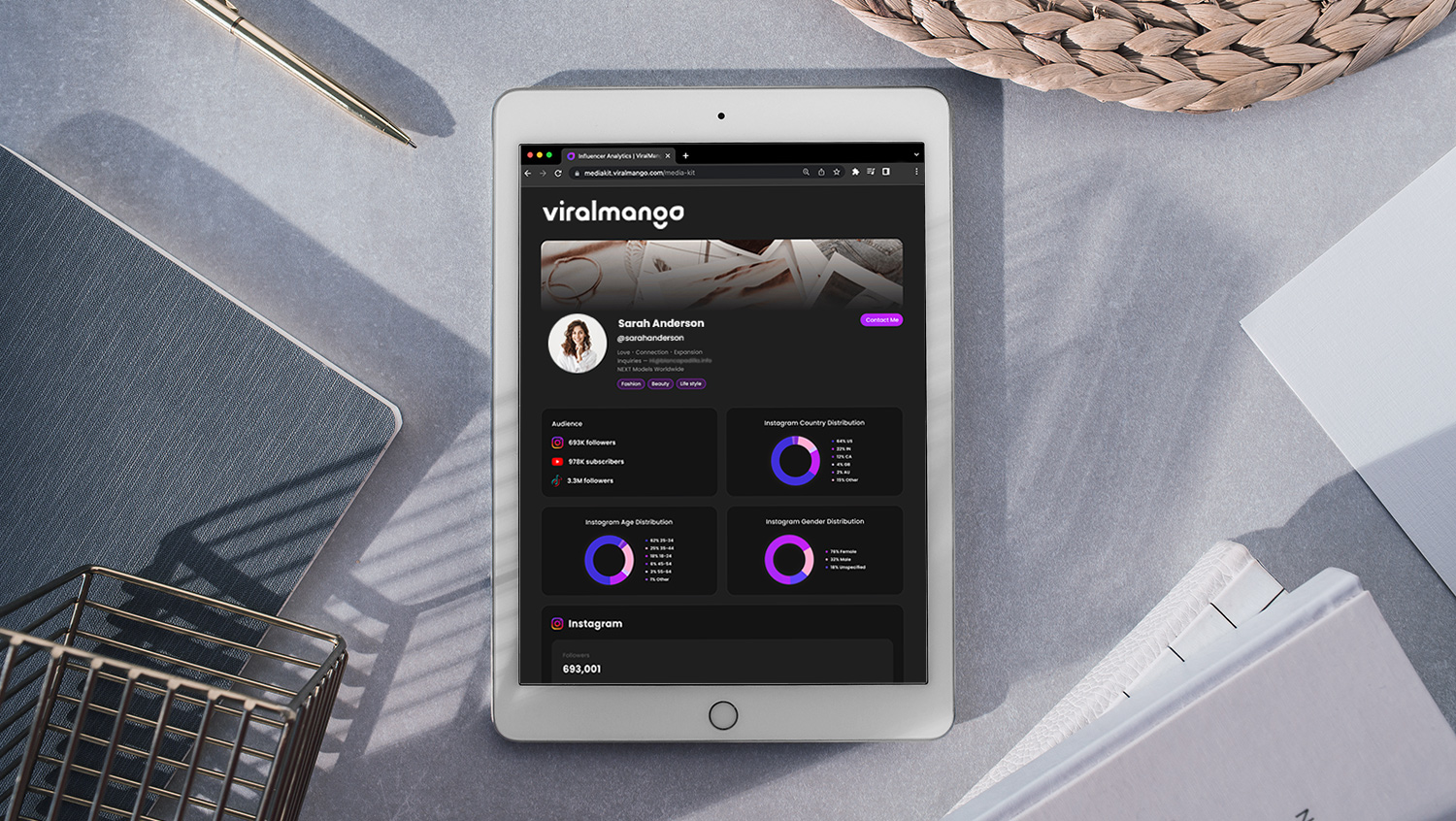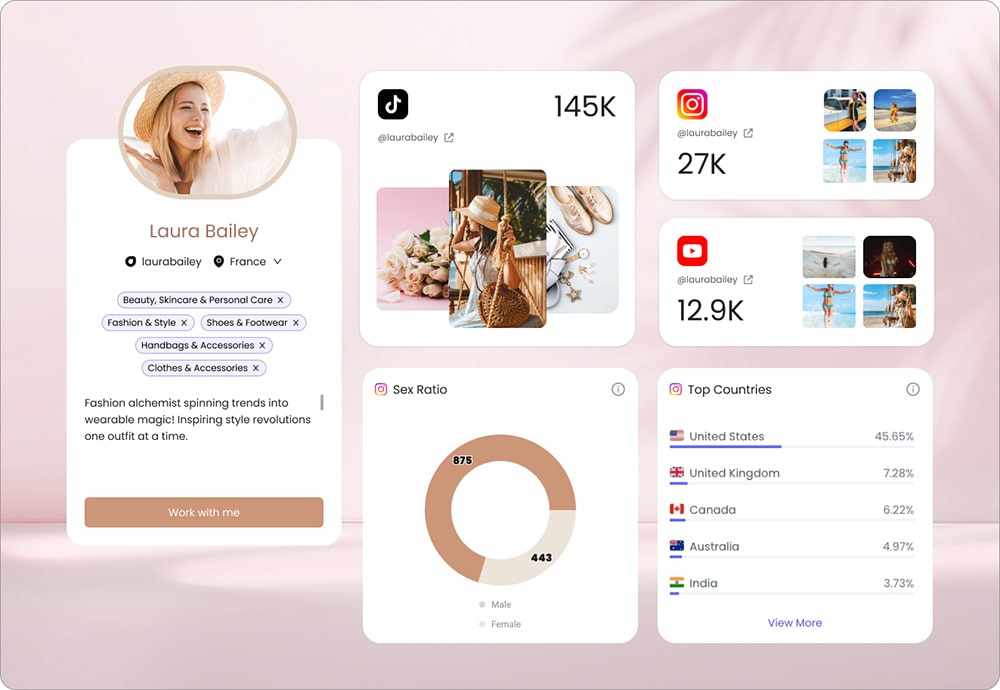As the influencer marketing world keeps growing, the competition gets stiffer. Algorithm changes and a bunch of other challenges make it harder for influencers to get noticed.
Being an influencer isn’t just about posting content and collecting likes. It’s more about building a reputation and having a personal brand that stands out. Besides, you should be able to show your worth and achievements. This is why it’s important for you to have a powerful tool to present yourself and improve communication with brands.
Having an influencer media kit is the solution that you need. It’s like a portfolio that shows who you are, what you do, your achievements, and what you can offer brands. It’s the key to getting noticed and being approached to for more collaborations.
In this article, we’ll explain why you need an influencer media kit and guide you through creating one in three easy steps. We’ll cover where to start, what to include, and more. Let’s begin!
What is an influencer media kit?
Your media kit is basically a highlight of your influencer journey. It usually includes info about your background, your career story, and all the details that brands want to know. Think of it as your way of saying, “Hey, I’m the real deal, and here’s why you need me!”
It’s like a resume for professional influencers. It shows brands who you are and what you offer, so it’s crucial to make it well-structured, visually appealing, and up-to-date. An influencer media kit should give details about your audience size and demographics, engagement rates, previous partnership examples, rates, and links to your social profiles.
So, if you still don’t have a media kit, it’s time to create one. It will help you build relationships with brands, show off your unique style, and let your skills take center stage. Plus, it lets you track what’s working best to attract potential collaborations in an organized way.
Why do you need a media kit?
Before we get all creative with your media kit, let’s take a step back and talk about why it’s a game-changer for your influencer journey.
Picture this: Brands are on the lookout for awesome influencers like you to team up with. But how do they know you’re the one they’ve been looking for? That’s where your media kit steps in. It’s like your digital business card, showcasing your style, skills, and all those fantastic achievements you’ve racked up, and… helps you secure your next brand deal.
So, below are the key reasons why you need a media kit:
Provide information about you
Your media kit is an overview of all the things that make you, well, you! Think of it as your digital introduction, your friendly wave to the world. It includes all the essential insights about your creator journey, your interests, the niche you’re in, and the kind of content that you create for your audience and partners.
Brands love this peek into your world. The information presented in your media kit helps them understand your personality, style and value, making it easier for them to determine if you are a good fit for their campaigns or not.
Showcase your professionalism
When brands catch a glimpse of your carefully crafted media kit, they instantly see that you’re not just here to play—it’s clear you mean business. When you’ve put effort into presenting yourself in a clear, organized way, you’re showcasing a level of professionalism that brands can’t help but respect.
A well-crafted media kit shows that you take your work seriously and are ready to deliver results. This increases your credibility and helps brands to consider potential partnerships with you.

Land better brand deals
Having an influencer media kit can improve your chances of securing better brand deals. Brands are looking for influencers to bring their visions to life. They’ve got a checklist—your media kit ticks all the boxes.
It’s like handing them a neatly wrapped package with everything they need to know about you. Your strengths, your audience’s specifics, and a dazzling display of past successful collaborations—it’s all in one place.This makes it super easy for them to see why you’re the one to make their visions come to life.
In a world filled with influencers, your media kit is your spotlight. It sets you apart, shining a light on the unique sparkle that only you can bring to the table.
Negotiate with confidence
When stepping into a negotiation, you’re armed with an arsenal of facts and figures if you have your media kit ready and up-to-date. With solid data on your side—like your audience size that’s rapidly growing, high engagement rates, and the success stories of past campaigns, you can negotiate with brands more confidently.
You’re not just discussing terms; you’re showcasing your worth. Armed with these insights, you can land a deal, ensuring everyone walks away with smiles and satisfaction.
How to create a winning media kit in 3 easy steps?
Now that you know what an influencer media kit is and how it can help you, let’s see how you can make one for yourself. The good news is, creating a media kit is easy, and you can do it in just three steps.
Understand the goal 🎯
Step 1
The first step in making your influencer media kit is to know why you’re doing it. When you define and understand your goal, it will help you with the next steps. Your influencer media kit is a reflection of you, your creativity, and your aspirations. So, take a moment to think about your “why.”
Ask yourself: What’s the big idea behind your media kit? Are you looking to collaborate with brands? Are you aiming to showcase your unique style? Or maybe it’s about sharing your story with the world?
Here’s how you can figure out your goal:
What to include in your media kit ✍🏻
Step 2
Now, let’s talk about what content you should include in your influencer marketing kit. You have some flexibility here because you want to show your strengths. Imagine you’re creating your highlight reel. What’s the magic ingredient that makes you stand out? It could be your impressive engagement rates, your storytelling style, or the awesome campaigns you’ve aced.
So, you can choose to include certain information and leave out others. However, there are some key things you should definitely include if you want to stand out and secure collaborations successfully.
Choose a format and design 🎨
Step 3
The final step is designing your influencer media kit, and it’s a crucial one that you shouldn’t overlook. In the world of social media, visuals are everything, and a beautifully-designed kit is another way to show that you can create eye-catching and stylish content in various forms.
It’s your chance to let your creativity shine. Remember, brands are scrolling through tons of media kits, and yours needs to be the one that stops them in their tracks. Show them that not only can you create stunning content, but you also know how to package it like a pro.
Whether you’re sending a PDF attached to an email or a sleek digital link, make sure it’s a smooth experience for whoever’s on the receiving end. Accessibility is key here.
Here’s how you can ensure that your influencer media kit is well-designed and easily accessible:
From a captivating bio that introduces you in style, to showcasing your social media platforms, audience demographics, performance metrics, previous collaborations, rates, and contact details, you’ve got all the ingredients for a comprehensive and irresistible kit.
With these insights, you’re ready to dive into the influencer world with a kit that stands out for its visual appeal, professionalism, and user-friendly design. Get ready to attract collaborations that align with your passion and showcase your influencer magic like never before.
Influencer media kit examples
Check out some media kit examples for influencers below. These carefully curated examples offer a glimpse into how successful influencers present their unique brand, engagement metrics, and previous collaborations to attract potential partnerships.
Get inspired to create a media kit that effectively showcases your personality and strengths as an influencer!
Frequently Asked Questions
To send your influencer media kit, compose a personalized email to brands expressing interest in collaboration. Attach a concise PDF or share a digital link showcasing your strengths, engagement rates, past work, and audience demographics. Ensure accessibility across devices. Keep subject lines attention-grabbing, and follow up if needed. Stay positive and professional in all interactions – authenticity is key!
Update your media kit every time you have new achievements, changes in rates, new collaborations, or improved performance. Keep your media kit up to date to show brands you’re proactive and reliable. Depending on your media kit format, you can update your numbers manually, if it’s a PDF, or if it’s a media kit builder like ViralMango, your performance data will be updated automatically.
When creating your media kit, remember that its length can vary based on what you want to share and what brands are looking for. It’s generally recommended to keep it concise and focused. A typical influencer media kit is usually 2 to 6 pages long, including content and visuals.
A media kit targets brand partners and influencers, showcasing engagement metrics and collaboration opportunities. While, a press kit is for journalists, providing company information, press releases, and high-resolution images to generate media coverage.
A compelling media kit increases your chances of attracting brands and landing exciting deals. To secure brand deals using your influencer media kit, reach out to brands expressing interest in collaboration. Attach or link your media kit, emphasizing your strengths and past successes. Highlight your uniqueness, showcase successful partnerships, and customize outreach for each brand.
By Rem Darbinyan
Revolutionizing industries with AI, Rem Darbinyan is the CEO of ViralMango and an entrepreneur, AI expert, and influencer marketing strategist.

Reviewed By Rem Darbinyan
Revolutionizing industries with AI, Rem Darbinyan is the CEO of ViralMango and an entrepreneur, AI expert, and influencer marketing strategist.













